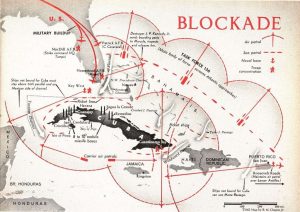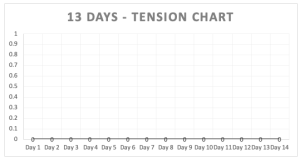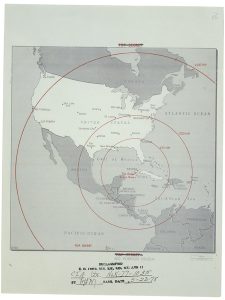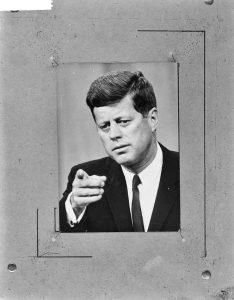51 Cuban perspectives on the Cuban Missile Crisis by Devon Bennett
1. Evaluating tensions: timeline activity

Blockade over Cuba 1962, Author unknown, Wikimedia Commons (Public Domain)
| Curriculum context | VCE Modern History Unit 2 (VCAA, 2020) |
| Historical context | Cuban Missile Crisis 1962 |
| Historical thinking concepts | Evidence and interpretation
Historical perspectives |
| Learning intentions | Students can evaluate the Cold War tensions during the Cuban Missile crisis and display their data in a graph.
Students can explain and justify their choices in the data with connections to the historical events of the Cuban Missile Crisis. Students can revise their data when centring the Cuban perspective. |
Activity
Part 1: Tensions timeline
Using the information this source on key moments in the Cuban Missile crisis you will view the events from October 16 – October 29, 1962 and evaluate the tension (likelihood of war). You will rank each day and put it in the graph with 0 equating to peace and 10 equating to war. There should be no days ranked at 10.

Chart created by author
- Explain why you selected your highest tension day. Make sure you use historical evidence to support your answer.
- Identify whose perspective is centred when you were evaluating the tension? Justify in a short response using evidence and reasoning.
- If you were to centre the Cuban perspective in this chart, what would you revise and why? Justify your answer using historical evidence (you may need to research this).
- Was it more challenging for you to centre the Cuban perspective? Explain.
- Analyse what this tells you about the historical evidence relating to the Cuban Missile Crisis? Identify any biases.
- In an extended response, identify the tensions between ideologies of the American, Russian, and Cuban perspectives.
Part 2: Historical source analysis

Map of Missile Range in Cuba, National Archives, Public Domain
- Identify the information Source 1 conveys.
- List the countries in the source which would have been threatened by the missiles in Cuba.
- Analyse what the map communicated to the Kennedy and his administration.
- Washington D.C. falls within the second circle of the map. What can be inferred from the CIA’s map?
- Looking at the nautical mile (NM) measurements marked on the map, explain what could be considered odd about them?
- Explain how these measurements might increase the urgency of response from President Kennedy.
References
Kiger, P. J. (2019). Key Moments of the Cuban Missile Crisis. History Channel. https://www.history.com/news/cuban-missile-crisis-timeline-jfk-khrushchev
VCAA. (2020). VCE Study Design: History 2022-2026. Victorian Curriculum and Assessment Authority. https://www.vcaa.vic.edu.au/curriculum/vce/vce-study-designs/history/Pages/index.aspx
2. Evaluating historical perspectives on the Cuban Missile Crisis

Militaire blokkade van Cuba, President Kennedy by The Algemeen Nederlandsch Fotobureau, Picryl, Public Domain
| Curriculum Context | VCE Modern History Unit 2 (VCAA, 2022) |
| Historical context | Cuban Missile Crisis, 1962 |
| Historical thinking concepts | Evidence and interpretation
Continuity and change Historical significance |
| Learning intentions | Students can interpret historical sources and evidence and write an analysis of them.
Students can assess how the Cuban perspective is situated in the Cuban Missile Crisis through historical sources. Students can identify biases and their causes. |
Activity
Source 1
“We were eyeball to eyeball and I think the other fellow just blinked.”
Dean Rusk, US Secretary to State on the Cuban missile crisis, October 1962 (Alpha History, 2023)
Questions:
- Identify the historical perspective of this quote (traditional, revisionist, post-revisionist).
- Describe the context of the above quote. Use your historical knowledge.
- Using your historical knowledge, and historical interpretations, assess how this quote by the US Secretary of State included or excluded the Cuban perspective during the Cuban Missile Crisis.
- To what extent does this quote reflect the American sentiment towards the USSR during the Cold War more broadly? Discuss.
- Explain how this quote pertain to the ‘brinkmanship’ that the US and the USSR were known for during the Cold War? Include a brief definition of ‘brinkmanship’ in your answer.
Source 3
“Photographs were shown to us. Experts arrived with their charts and their pointers and told us if we looked carefully we could see there was a missile base being constructed in a field near San Cristobal. I for one had to just take their word for it. I looked and I examined the pictures carefully and what I saw appeared to me no more than clearing a field for a farm or the basement of a house. I was relieved to hear later that this was the same reaction of virtually everyone at the meeting, including President Kennedy.”
Robert F. Kennedy, Thirteen Days draft. (Kennedy, 1967)
Questions:
- Analyse how Robert F. Kennedy’s recollection of being shown the CIA photos from his memoir Thirteen Days explains President Kennedy’s blockade approach?
- Thirteen Days is considered a traditionalist perspective, discuss how the above excerpt could support a revisionist reading.
- John F. Kennedy was assassinated in 1963. This made him the perfect American President. To what extent did his death contribute to the traditionalist perspective of the Cuban Missile Crisis? Write a short response using evidence.
Source 4

This hurts you more than it hurts us by Edmund Valtman 1962, Library of Congress, Public Domain,
Questions:
- Identify the people portrayed in Source 4.
- What can you infer from this image about Cuba’s sovereignty and power?
- In a short response, analyse what the artist is conveying through this image about Fidel Castro and Cuba’s position during the Cuban Missile Crisis.
References
History, A. (2023). Quotations: Kennedy, Cuba and the Cuban Missile Crisis, 1960s. https://alphahistory.com/coldwar/quotations-kennedy-cuba-1960s/
Kennedy, R. F. (1967). Subject Files: Kennedy, Robert F.: Cuban Missile Crisis Article, [Thirteen Days Draft]. John F. Kennedy Presidential Library and Museum. https://www.jfklibrary.org/asset-viewer/archives/JBKOPP/SF079/JBKOPP-SF079-001?image_identifier=JBKOPP-SF079-001-p0001

